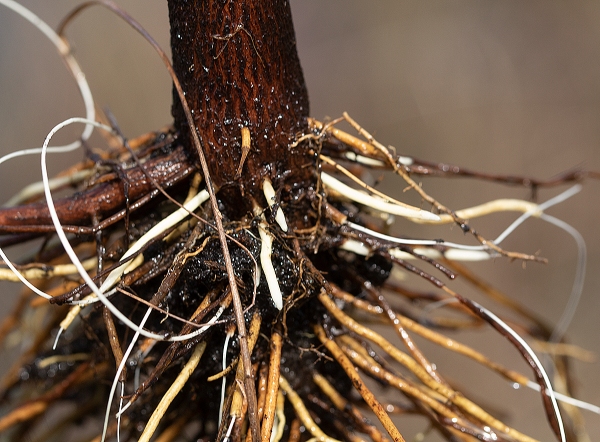Living Labs of Unstudied Ecology
Around Palm Beach and Martin counties are thousands of shallow depressions ranging from a few yards to hundreds of yards in diameter. A few hold water year-round. A few seldom-to-never hold standing water. Most are flooded during the rainy months, and droughty and crusty during the dry season. Most of the seasonally flooded depressions are dominated by two shrubs coexisting hand-in hand: Corkwood (Stillingia aquatica) and Peelbark St. Johnswort (Hypericum fasciculatum). These marshes don’t have a formal name, so I call them Hypericum-Stillingia marshes. They are an intriguing yet virtually unstudied ecosystem.

H-S marsh. Look how shrubs cluster around the tree bases.
What a harsh environment! Under water half the year, and a sun-baked desert the other half. Which season is worse… suffocating submerged roots in the summer-autumn, or dry-roasting the rest of the year? Every species must cope with both extremes, and each has its own mechanisms for dealing with the seasonal double whammy. Every species there has its own story. Let’s look at the key players: Hypericum and Stillingia.

Above, Hypericum. Below, Stillingia.

How does Hypericum survive the flooding? It has an extremely shallow roots system snaking around just under the surface, and little “snorkels” rising up into the standing water where there is dissolved oxygen.

Hypericum roots with snorkels
There are also stilt roots around the base of the trunk, able to capture oxygen even when there’s flooding below. They also capture algae and nitrogen-fixing cyanobacteria, which probably helps with mineral nutrition.

The same species in the hot dry season benefits skinny leaves resembling conifer needles, and from protective bark far thicker than that known on any other local shrub.
Stillingia aquatica differs by having, instead of wandering shallow roots, comparatively deep roots in a crowded mass, and with built-in air canals near the water surface.

Stillingia roots
The base of the root mass is deep enough to stay where the soil remains moist year-round, and the air canals up high handle ventilation. The leaves are narrow, and, like some desert plants (you know, cacti), the trunk has thick green tissue able to photosynthesize with minimal water loss. The flowers are far out in a marsh where pollinating insects are scarce. The strongest cross-marsh fliers are wasps, drawn from afar to the tuft of yellow bracts under the flowers, and fueled by little nectar goblets on the stem near the flowers. As is also true of Hypericum, in Stillingia if insects fail to bring pollen the plant pollinates itself as a reproductive safety net. Stillingia seeds are built for both seasons: they can float when flooded, and each has built-in ant food for ant assistance during dry times.

Yellow bracts

Nectar goblet

Stillingia seed with ant bait
A completely different set of woody species lives on the raised hummocks above the highwater line. The hummocks are masses of tree roots, mostly from Slash Pines, with accumulated organic debris and oodles of ants. Eight species “own” the hummocks: Cocoplum, Dahoon Holly, Muscadine Grape, Myrsine, Saw Palmetto, Smilax, Swamp Bay, and Wax Myrtle. What almost all have in common is small bird-dispersed fruits rained down by birds sitting in the Slash Pines. Most of the hummocks host masses of Wax Myrtle, which, as a nitrogen-fixing species, will be found by future ecologists to fertilize the other hummocks species.

Cyanobacteria = Blue Green Algae
Bird droppings from the pines are great sources of phosphorus. The plants are conspicuously extra-large near major bird nesting sites. What’s tricky to explain is that most of the hummock-dwelling shrubs (but none of the bottom-dwellers) are dioecious, that is, have separate male and female individuals. Reasons for this are unknown, although dioecy correlates with harsh seedling conditions, including shade. Makes sense, given that a completely female dioecious plant can specialize on making particularly tough shade-tolerant seedlings instead of using half its resources for male functions, making and dispersing pollen.
In short, the Hypericum-Stillingia marsh is a living laboratory of unusual nutritional relationships, odd root structures, unique pollination challenges, complex breeding systems, and adaptations to tolerate two environmental extremes in the same plants. On one hand, it is surprisingly how minimally these systems are known. On the other hand, I like the unexplored mysteries right under our noses. That’s what makes it all so much fun. Anybody can go to an Hypericum-Stillingia marsh and delve into the unknown for an hour.

Ant carton nest “treehouse” high and dry above the flood.
Felicity Rask
October 28, 2022 at 8:21 pm
Yes, finally, someone in S Florida skirting the pond. Not the one on the other side of the Atlantic but the Ephemeral ponds, Vernal pools, Depression Marsh, or whatever name one uses depending on what part of the US one lives in. Rapidly disappearing because they are poorly understood and undervalued. They cannot support fish so they are breeding places for Salamanders and other squiggly things which are also disappearing. Next time you visit Vero Beach please contact me so I can show you the one I have discovered on my son’s 8.8 acre property east of I95.
Rebecca Means at Coastal Plains Institute 46 Kinsey Road Crawfordville, FL 32327 offered to try and help me identify the squiggly things. At which point Vero was hit by a summer long drought and no squiggly things to photograph! Hoping for better luck next year….